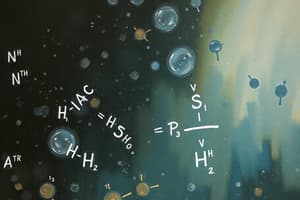Podcast
Questions and Answers
What is the rate of reaction?
What is the rate of reaction?
How quickly or slowly reactants turn into products in chemical reactions.
What are the 5 factors that affect the rate of a chemical reaction?
What are the 5 factors that affect the rate of a chemical reaction?
Temperature, concentration, surface area, pressure, and the presence of a catalyst.
How does temperature affect the rate of reaction?
How does temperature affect the rate of reaction?
Increasing temperature causes particles to move faster, leading to more frequent and effective collisions.
What is concentration in terms of chemical reactions?
What is concentration in terms of chemical reactions?
How does surface area impact the rate of reaction?
How does surface area impact the rate of reaction?
What is a catalyst?
What is a catalyst?
What is the effect of pressure on the rate of reaction?
What is the effect of pressure on the rate of reaction?
What is kinetics in relation to chemical reactions?
What is kinetics in relation to chemical reactions?
How is the rate of a reaction mathematically expressed?
How is the rate of a reaction mathematically expressed?
What is activation energy?
What is activation energy?
What does collision theory state?
What does collision theory state?
What is enthalpy?
What is enthalpy?
What characterizes an exothermic reaction?
What characterizes an exothermic reaction?
In an endothermic reaction, what happens to energy?
In an endothermic reaction, what happens to energy?
What happens when bonds are formed?
What happens when bonds are formed?
What happens when bonds are broken?
What happens when bonds are broken?
What is the symbol for enthalpy?
What is the symbol for enthalpy?
Flashcards are hidden until you start studying
Study Notes
Rate of Reaction
- Describes the speed at which reactants convert to products in chemical reactions.
- Influenced by multiple factors.
Factors Affecting Reaction Rate
- Five key factors: temperature, concentration, surface area, pressure, and catalysts.
Temperature
- Increasing temperature accelerates particle movement, leading to more frequent and effective collisions.
- Higher temperatures result in higher reaction rates due to increased kinetic energy.
Concentration
- Concentration measures the amount of solute in a solution.
- Greater concentration leads to a faster reaction rate as more particles increase collision frequency.
Surface Area
- Surface area refers to the exposed area of an object.
- Increased surface area from smaller particles results in more collisions, enhancing reaction rates.
Catalyst
- Catalysts speed up reactions without being consumed, lowering activation energy.
- Alters reaction mechanisms, enabling processes (like enzyme function) at lower temperatures.
Pressure
- Elevated pressure compresses particles closer together, increasing reaction rates by facilitating more collisions.
Kinetics
- Kinetics is the study of reaction rates and the mechanisms involved in chemical processes.
Activation Energy
- The minimum energy required to initiate a chemical reaction, which can vary significantly.
- Activation energy can be supplied from the environment or added by a chemist.
Collision Theory
- A reaction occurs when two particles collide with proper orientation and sufficient kinetic energy to overcome activation energy.
Enthalpy
- Represents the energy changes within a system during a reaction, encompassing total heat content and potential energy.
Exothermic Reactions
- More energy is released than absorbed, resulting in more stable products.
- Associated with bond formation; the reaction releases heat indicated on the product side of the equation.
Endothermic Reactions
- Absorb more energy than they release, leading to less stable products.
- Associated with bond breaking; the reaction absorbs heat indicated on the reactant side of the equation.
Breaking and Forming Bonds
- Breaking bonds requires energy (endothermic).
- Forming bonds releases energy (exothermic).
Symbol for Enthalpy
- Represented by ΔH (delta H), indicating the change in heat content.
- ΔH is calculated as ΔH = Hp - Hr (products - reactants), reflecting the energy difference in a reaction.
Studying That Suits You
Use AI to generate personalized quizzes and flashcards to suit your learning preferences.




